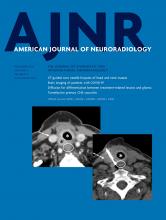Index by author
Baker, J.C.
- EDITOR'S CHOICEHead & NeckYou have accessPercutaneous CT-Guided Core Needle Biopsies of Head and Neck Masses: Technique, Histopathologic Yield, and Safety at a Single Academic InstitutionT.J. Hillen, J.C. Baker, J.R. Long, M.V. Friedman and J.W. JenningsAmerican Journal of Neuroradiology November 2020, 41 (11) 2117-2122; DOI: https://doi.org/10.3174/ajnr.A6784
This is a retrospective review of head and neck biopsies performed from January 2013 through December 2019. Clinical diagnosis and indication, patient demographics, mass location and size, biopsy needle type, technical approach, dose-length product, sedation details, complications, diagnostic histopathologic yield, and the use of iodinated contrast were recorded for each case. Twenty-seven CT-guided head and neck core needle biopsies were performed in 26 patients. The diagnostic sample rate was 100% (27/27). A concordant histopathologic diagnosis was obtained in 93% (25/27) of cases. There was a single complication of core needle biopsy, a small asymptomatic superficial hematoma.
Bandettini, M.
- InterventionalYou have accessCarotid Stenting and Mechanical Thrombectomy in Patients with Acute Ischemic Stroke and Tandem Occlusions: Antithrombotic Treatment and Functional OutcomeV. Da Ros, J. Scaggiante, F. Sallustio, S. Lattanzi, M. Bandettini, A. Sgreccia, C. Rolla-Bigliani, E. Lafe, G. Sanfilippo, M. Diomedi, M. Ruggiero, N. Haznedari, M. Giannoni, C. Finocchi and R. FlorisAmerican Journal of Neuroradiology November 2020, 41 (11) 2088-2093; DOI: https://doi.org/10.3174/ajnr.A6768
Bar-yosef, O.
- PediatricsYou have accessFetal Exposure to MR Imaging: Long-Term Neurodevelopmental OutcomeE. Zvi, A. Shemer, S. toussia-Cohen, D. Zvi, Y. Bashan, L. Hirschfeld-dicker, N. Oselka, M.-M. Amitai, O. Ezra, O. Bar-Yosef and E. KatorzaAmerican Journal of Neuroradiology November 2020, 41 (11) 1989-1992; DOI: https://doi.org/10.3174/ajnr.A6771
Barber, P.A.
- Adult BrainOpen AccessDynamic CTA-Derived Perfusion Maps Predict Final Infarct Volume: The Simple Perfusion Reconstruction AlgorithmC.C. McDougall, L. Chan, S. Sachan, J. Guo, R.G. Sah, B.K. Menon, A.M. Demchuk, M.D. Hill, N.D. Forkert, C.D. d’Esterre and P.A. BarberAmerican Journal of Neuroradiology November 2020, 41 (11) 2034-2040; DOI: https://doi.org/10.3174/ajnr.A6783
Barchetti, G.
- InterventionalYou have accessUse of Cangrelor in Cervical and Intracranial Stenting for the Treatment of Acute Ischemic Stroke: A “Real Life” Single-Center ExperienceA. Cervo, F. Ferrari, G. Barchetti, L. Quilici, M. Piano, E. Boccardi and G. PeroAmerican Journal of Neuroradiology November 2020, 41 (11) 2094-2099; DOI: https://doi.org/10.3174/ajnr.A6785
Bashan, Y.
- PediatricsYou have accessFetal Exposure to MR Imaging: Long-Term Neurodevelopmental OutcomeE. Zvi, A. Shemer, S. toussia-Cohen, D. Zvi, Y. Bashan, L. Hirschfeld-dicker, N. Oselka, M.-M. Amitai, O. Ezra, O. Bar-Yosef and E. KatorzaAmerican Journal of Neuroradiology November 2020, 41 (11) 1989-1992; DOI: https://doi.org/10.3174/ajnr.A6771
Beaujeux, R.
- InterventionalOpen AccessStroke Thrombectomy in Patients with COVID-19: Initial Experience in 13 CasesR. Pop, A. Hasiu, F. Bolognini, D. Mihoc, V. Quenardelle, R. Gheoca, E. Schluck, S. Courtois, M. Delaitre, M. Musacchio, J. Pottecher, T.-N. Chamaraux-Tran, F. Sellal, V. Wolff, P.A. Lebedinsky and R. BeaujeuxAmerican Journal of Neuroradiology November 2020, 41 (11) 2012-2016; DOI: https://doi.org/10.3174/ajnr.A6750
Beck, J.
- FELLOWS' JOURNAL CLUBAdult BrainOpen AccessMonro-Kellie Hypothesis: Increase of Ventricular CSF Volume after Surgical Closure of a Spinal Dural Leak in Patients with Spontaneous Intracranial HypotensionT. Dobrocky, M. Rebsamen, C. Rummel, L. Häni, P. Mordasini, A. Raabe, C.T. Ulrich, J. Gralla, E.I. Piechowiak and J. BeckAmerican Journal of Neuroradiology November 2020, 41 (11) 2055-2061; DOI: https://doi.org/10.3174/ajnr.A6782
Nineteen patients with spontaneous intracranial hypotension with a proved spinal CSF leak were investigated between July 2014 and 2017. Brain MR imaging-based volumetry at baseline and after surgery was performed with FreeSurfer. In addition, the spontaneous intracranial hypotension score, ranging from 0 to 9, with 0 indicating very low and 9 very high probability of spinal CSF loss, was calculated. The authors conclude that the study demonstrated a significant increase in ventricular CSF volume in the early follow-up after surgical closure of the underlying spinal dural breach, and may provide a causal link between spinal CSF loss and spontaneous intracranial hypotension. The concomitant decrease in the spontaneous intracranial hypotension score postoperatively implies the restoration of an equilibrium within the CSF compartment.
Belavy, D.L.
- FELLOWS' JOURNAL CLUBSpineYou have accessVariability of T2-Relaxation Times of Healthy Lumbar Intervertebral Discs is More Homogeneous within an Individual Than across Healthy IndividualsA. Sharma, R.E. Walk, S.Y. Tang, R. Eldaya, P.J. Owen and D.L. BelavyAmerican Journal of Neuroradiology November 2020, 41 (11) 2160-2165; DOI: https://doi.org/10.3174/ajnr.A6791
Using prospectively acquired T2-relaxometry data from 606 intervertebral discs in 101 volunteers without back pain in a narrow age range (25–35 years), the authors calculated intra- and intersubject variation in T2 times of IVDs graded by 2 neuroradiologists on the Pfirrmann scale. Intrasubject variation of IVDs was assessed relative to other healthy IVDs (Pfirrmann grade, #2) in the same individual. Multiple intersubject variability measures were calculated using healthy extraneous references ranging from a single randomly selected IVD to all healthy extraneous IVDs, without and with segmental stratification. They conclude that the study demonstrates a significantly higher variation in the T2 times of IVDs across subjects, and suggests that normative measures based on the T2 times of healthy lumbar IVDs from the same individual are likely to provide the most discriminating means of identifying degenerated IVDs on the basis of T2 relaxometry.
Beppu, M.
- InterventionalOpen AccessComputational Fluid Dynamics Using a Porous Media Setting Predicts Outcome after Flow-Diverter TreatmentM. Beppu, M. Tsuji, F. Ishida, M. Shirakawa, H. Suzuki and S. YoshimuraAmerican Journal of Neuroradiology November 2020, 41 (11) 2107-2113; DOI: https://doi.org/10.3174/ajnr.A6766








